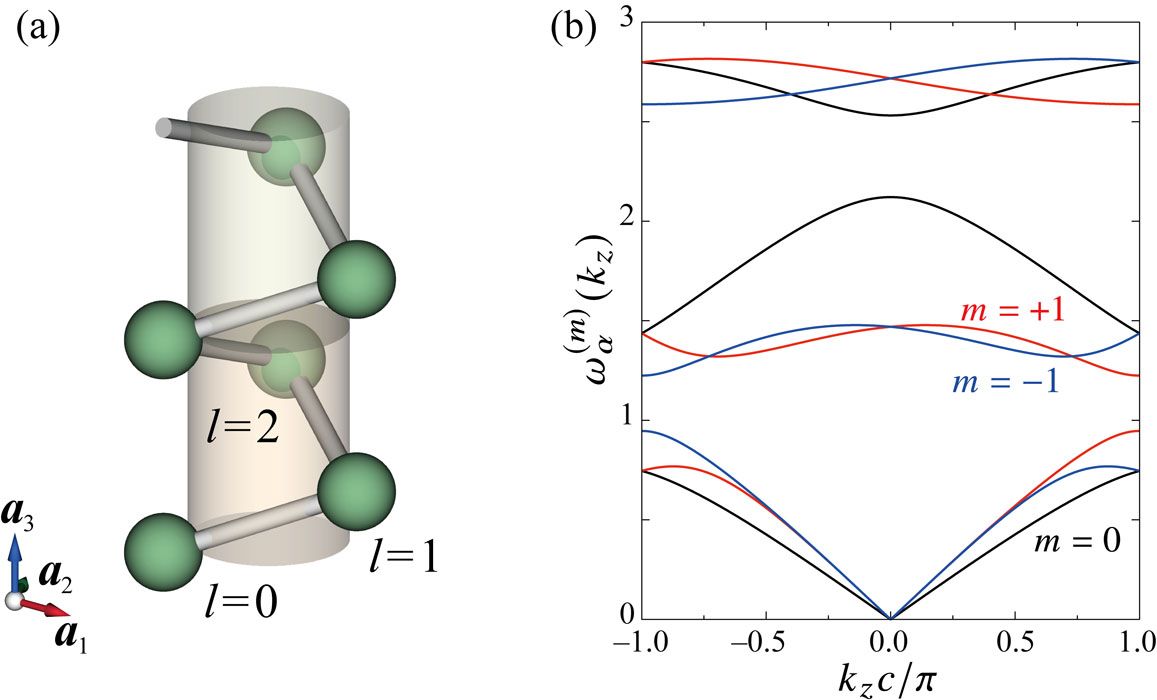Theory of Energy Splitting of Chiral Phonons
PI of Joint-use project: H. KusunoseHost lab: Tsunetsugu Group
Chirality is a property manifesting that the system’s structure cannot overlap with its mirror image by using any combination of translation and rotation alone, and chiral materials exhibit many interesting cross correlations in their electromagnetic and/or thermal properties. This is due to the property that polar-vector inputs can induce axial-vector outputs and vice versa in those systems in addition to ordinary responses, and this cross-correlated response is governed by a “order parameter” represented by an electric toroidal multipole of some rank [1]. Many of the preceding studies on the chiral systems have focused on their electronic properties, since the cross correlated electromagnetic responses are mainly governed by those degrees of freedom.
We have conducted a project to theoretically investigate the effects of chiral structure on phonon properties with mainly targeting tellurium and its related systems [2]. It has been known that these systems have a special quantum number related to their chirality, and it is crystal angular momentum (CAM) m. The main issue is how to characterize an energy splitting of chiral phonons with different CAM values (m = ±1). Chiral phonons have an elliptic polarization of atomic displacement that rotates clockwise or anticlockwise depending on the sign of CAM m.
For studying this problem, we have first performed a model building within the harmonic approximation for the lattice deformation energy and constructed a related dynamical matrix, the eigenvalues of which determine phonon energies. We have found an important constraint for the dynamical matrix that guarantees the stability of the atomic equilibrium positions in the given chiral structure. Taking account of this constraint, we have shown that the sound velocity of chiral phonons is identical independent of the sign of CAM m, and this disproves some precedent discussions expecting different velocities. Energy splitting Δω between the m = ±1 CAM modes is remarkable for optical phonons, and it is linear in the phonon momentum kz along the chiral axis as Δω = Γkz m around kz = 0. We have derived a simple formula for the coefficient Γ of this linear splitting represented in terms of microscopic stiffness constants in the dynamical matrix. This is a pseudo-scalar and corresponds to an electric toroidal monopole of the system.
In order to check this and further study the effects of chiral structure on phonon energy dispersion, we have also proposed a lattice model for which one can control its lattice chirality continuously. Its one limit is a set of three decoupled chiral tellurium-like lattices, while the other limit is a non-chiral coupled system with mirror symmetry. We have confirmed the above findings for the chiral system and found that the chirality-related energy splitting of optical phonons continuously vanish as we control the system towards the non-chiral limit. This type of energy splitting between two optical phonon modes had been recently observed by Raman scattering experiment, and the assignment of CAM quantum number was simultaneously performed to those two modes using the polarization selection rule [3], which is consistent with the theoretical predictions. We are planning to continue the study on chiral phonons and clarify other interesting properties related to several galvano-electric and galvano-magnetic responses.
References
- [1] S. Hayami, M. Yatsuhiro, Y. Yanagi, and H. Kusunose, Phys. Rev. B 98, 165110 (2018).
- [2] H. Tsunetsugu and H. Kusunose, J. Phys. Soc. Jpn. 92, 023601 (2023).
- [3] K. Ishito et al., Nat. Phys. 19, 35 (2023).

